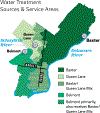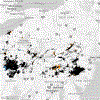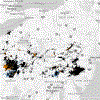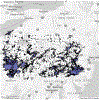Drinking Water Contaminant Concentrations and Birth Outcomes
- PMID: 38983462
- PMCID: PMC11230651
- DOI: 10.1002/pam.22558
Drinking Water Contaminant Concentrations and Birth Outcomes
Abstract
Previous research in the US has found negative health effects of contamination when it triggers regulatory violations. An important question is whether levels of contamination that do not trigger a health-based violation impact health. We study the impact of drinking water contamination in community water systems on birth outcomes using drinking water sampling results data in Pennsylvania. We focus on the effects of water contamination for births not exposed to regulatory violations. Our most rigorous specification employs mother fixed effects and finds changing from the 10th to the 90th percentile of water contamination (among births not exposed to regulatory violations) increases low birth weight by 12% and preterm birth by 17%.
Keywords: I18; Q52; Q53; birth outcomes; community water systems; drinking water contamination; low birth weight.
Figures





Similar articles
-
Associations between area-level arsenic exposure and adverse birth outcomes: An Echo-wide cohort analysis.Environ Res. 2023 Nov 1;236(Pt 2):116772. doi: 10.1016/j.envres.2023.116772. Epub 2023 Jul 28. Environ Res. 2023. PMID: 37517496 Free PMC article.
-
Examining the association between safe drinking water act violations and adverse birth outcomes in Virginia.Environ Res. 2023 Feb 1;218:114977. doi: 10.1016/j.envres.2022.114977. Epub 2022 Dec 1. Environ Res. 2023. PMID: 36463994 Free PMC article.
-
Nitrate in Drinking Water during Pregnancy and Spontaneous Preterm Birth: A Retrospective Within-Mother Analysis in California.Environ Health Perspect. 2021 May;129(5):57001. doi: 10.1289/EHP8205. Epub 2021 May 5. Environ Health Perspect. 2021. PMID: 33949893 Free PMC article.
-
Maternal arsenic exposure and birth outcomes: a comprehensive review of the epidemiologic literature focused on drinking water.Int J Hyg Environ Health. 2014 Sep;217(7):709-19. doi: 10.1016/j.ijheh.2014.03.004. Epub 2014 Mar 21. Int J Hyg Environ Health. 2014. PMID: 24713268 Free PMC article. Review.
-
Sources, pathways, and relative risks of contaminants in surface water and groundwater: a perspective prepared for the Walkerton inquiry.J Toxicol Environ Health A. 2002 Jan 11;65(1):1-142. doi: 10.1080/152873902753338572. J Toxicol Environ Health A. 2002. PMID: 11809004 Review.
Cited by
-
Impact of climate change and environmental adversities on maternal and fetal health: the role of clinical practices and providers in mitigating effects and prioritising women's health in the UK.Front Glob Womens Health. 2025 Jun 13;6:1483938. doi: 10.3389/fgwh.2025.1483938. eCollection 2025. Front Glob Womens Health. 2025. PMID: 40584728 Free PMC article. Review.
References
-
- Albouy-Llaty M, Limousi F, Carles C, Dupuis A, Rabouan S, & Migeot V (2016). Association between exposure to endocrine disruptors in drinking water and preterm birth, taking neighborhood deprivation into account: A historic cohort study. International Journal of Environmental Research and Public Health, 13(8), 796. 10.3390/ijerph13080796 - DOI - PMC - PubMed
-
- Almberg KS, Turyk ME, Jones RM, Rankin K, Freels S, & Stayner LT (2018). Atrazine contamination of drinking water and adverse birth outcomes in community water systems with elevated atrazine in Ohio, 2006–2008. International Journal of Environmental Research and Public Health, 15(9), 1889. 10.3390/ijerph15091889 - DOI - PMC - PubMed
-
- Almond D, Chay KY, & Lee DS (2005). The costs of low birth weight. The Quarterly Journal of Economics, 120(3), 1031–1083. 10.1093/qje/120.3.1031 - DOI
Grants and funding
LinkOut - more resources
Full Text Sources
